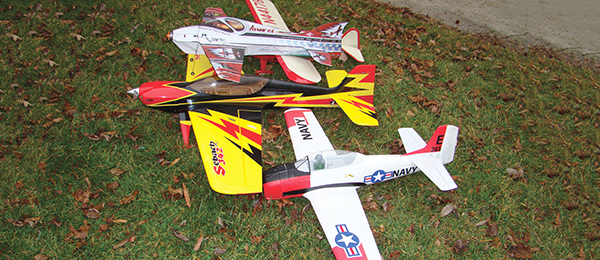
Written by Dave Lockhart Sport & Aerobatics As seen in the Spring 2020 issue of Park Pilot
>> For pilots who aspire to add new maneuvers to their repertoires, I am a big advocate of learning to perfect a slow roll. On the surface, a long, slow roll is not a spectacular maneuver, but performing it from one end of the field to the other is difficult to do. It is also a solid foundation for many maneuvers.
A long, slow roll requires accurate and concurrent use of aileron, elevator, and rudder inputs. Multiple control inputs must be completed in precise amounts with precise timing to produce a slow roll with constant altitude and no changes in flight direction. Depictions of the aircraft attitude, along with transmitter stick positions every 90° of roll, are shown to help visualize the slow roll maneuver.
Looking closer at a slow roll to the right and flying from left to right along the flightline, the maneuver starts from level flight with a small amount of aileron (right for this example). As the airplane rolls 90° to knife-edge with the right wing low, left rudder is needed to keep the airplane level in knife-edge flight (Photo 1). The left rudder input is not binary; it is gradually input as the airplane rolls from level to knife-edge flight.
As the roll progresses to 45°, a small amount of up-elevator is added then reduced as the roll progresses from 45° to knife-edge. The amount of rudder and elevator needed, as well as the timing, will vary depending upon the airplane.
As the roll continues from 90° (knife-edge) to 180° (inverted; Photo 2), the left rudder input is gradually removed. A small amount of down-elevator is added to maintain inverted flight. From 180° to 270° (left wing low, knife-edge; Photo 3), the down-elevator is slowly reduced while right rudder is slowly added.
As the last 90° of roll back to level flight is completed, the right rudder is gradually removed, and a small amount of up-elevator is used.
How does the slow roll translate to other maneuvers? Fast rolls use the same inputs, just more aileron and faster sequencing of the control inputs. Point rolls (or hesitation rolls) are, in essence, a slow roll with hesitations at every 90° (four-point roll) or every 45° (eight-point roll). Rolling harriers use the same inputs as a slow roll, but the amount of the inputs is increased greatly to keep the nose of the airplane higher, generating enough lift to keep the airplane from sinking at low speed.


How about a rolling circle? Consider the slow roll example. If the initial left rudder input is made too early, the nose of the aircraft will turn left and away from the flightline. If the down-elevator input is made early, the nose will turn farther from the flightline. If the right rudder is applied early, the flight path of the airplane will continue to follow a circle. As the roll is being completed, applying up-elevator early will again direct the flightpath in a circle.
In the previously described rolling circle instance, it is characterized as an “out”-rolling circle because the roll direction is toward the outside of the circle. An “in”-rolling circle can also be completed. With an in-rolling circle, the rudder and elevator inputs are completed relatively late, resulting in the flight path turning in versus turning out (early inputs).
The number of rolls per 360° circle can be controlled by the amount of the rudder and elevator inputs that are relative to the roll rate. Slower roll rates with relatively larger rudder and elevator inputs will produce a circle with fewer rolls.
Another maneuver utilizing similar inputs is a rolling loop. The rolling loop is just a rolling circle completed in the vertical plane instead of the horizontal plane. In essence, the rolling circle inputs are completed slightly earlier, held longer, and are slightly greater. The result is that the nose of the airplane is steered into a climb, as opposed to away from the flightline. To start the rolling loop, a small amount of up-elevator is added at the start of the roll to point the nose up. The initial left rudder input is exaggerated to further point the nose up. The amount of down-elevator is then increased, and the already climbing airplane will increase the climb angle. When the aircraft has completed 90° of loop and is essentially in a vertical climb, continuing the sequence of control inputs (timing and amounts) will direct the airplane back toward the direction it came from to complete half of a loop. Continuing the control inputs even more will eventually result in the completion of a rolling loop. Another consideration for the rolling loop versus the rolling circle is gravity. On the first and last quarter of the loop (bottom half), the airplane is working against gravity. On the second and third quarters of the loop (top half), gravity pulls the airplane back toward the ground. This means that the control inputs on the top half of the loop are relatively smaller than the inputs of the bottom half. It should go without saying that increased throttle is used on the climbing portion of the loop, and low throttle (perhaps even idle) is used on the diving portion of the loop.The described maneuvers are not easy to learn, but understanding the relationship between the maneuvers makes it easier to translate existing skills to new maneuvers. A well-designed, assembled, and well-set up aerobatic aircraft makes the challenge of learning the maneuvers easier.
To illustrate the desired aircraft attitude and transmitter stick positions, the screen captures shown are from the RealFlight simulator (realflight.com). The aircraft used is an F3P Expedition flown by Joseph Szczur, who competed on the US F3P World Championship team (teamusaf3p.com). The flight speed was intentionally slowed to show exaggerated aircraft attitude, control surface deflections, and stick positions.







